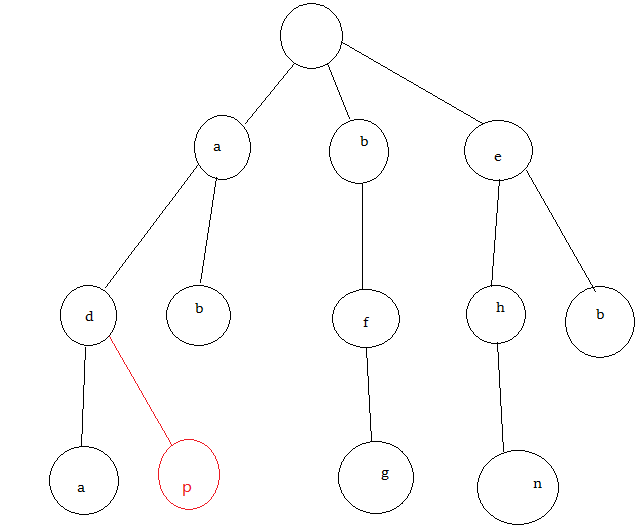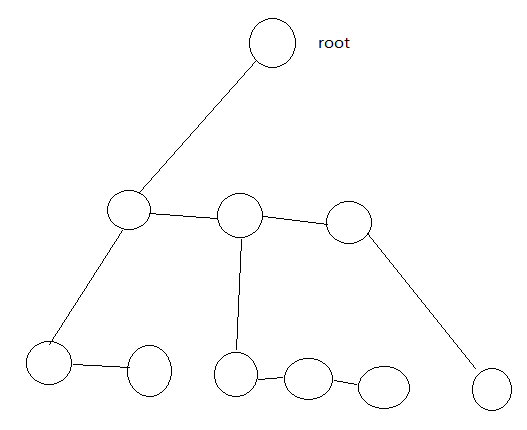引:假如有n(n很大)个字符串,有q个查询,每个查询表示在这n个串里面是否存在这个要查询的串。一种方法就是直接暴力查找,但是复杂度很高,稍微优化一点的方法是先把n个串排序,然后二分查找,但复杂度仍可以优化,hash或者字典树都可以,这里介绍字典树。
字典树是一颗树,每个节点都有多个子节点,子节点的数量取决于字符的范围,比如如果只有小写字母子节点就有26个就足够了,例如对于这六个字符串:ab, ada, bfg, ehn, eb, adp所构成的字典树如下:

注意红色部分是字典树的精华,对于ada和adp这两个字符串相同的前缀不会重复保存,即字典树不会重复保存没用的字符。
每个节点有些空节点就不画出来了,这里限制字符仅有小写字母,即每个节点有26个子节点,下标对应为0:a, 1:b, 2:c…………..
const int tp = 27; ///字符范围
struct node {
char val; /// 当前节点的字符
bool ifc; /// 这个节点是否是字符串的结束位置
struct node *next[tp]; ///子节点
} *root; /// root是字典树的根节点然后首先需要把n个字符串全部加入到字典树中才能够进行查询,插入操作很简单,只需要顺着树进行就可以了。
node* getNewNode() { ///生成新节点
node *p = new node;
for (int i = 0; i < tp; ++i) p->next[i] = NULL;
p->val = 0;
p->ifc = false;
}
void Insert(char *str) {
node *p = root; ///注意不要直接操作根节点
for (int i = 0; i < strlen(str); ++i) {
int tmp = str[i] - 'a'; ///获取下标
if (!p->next[tmp]) p->next[tmp] = getNewNode(); ///如果该节点为空则需要新建节点来延伸字典树
p = p->next[tmp]; ///传递到下一节点
}
p->ifc = true; ///注意在结束位置打上标记
}然后剩下的查找标记只需要顺着根节点来一步一步往下走就可以了
bool Find(char *str) {
node *rt = root; ///注意不要直接操作根节点
for (int i = 0; i < strlen(str); ++i) {
int tmp = str[i] - 'a';
if (rt->next[tmp]) rt = rt->next[tmp];
else return false;
}
return rt->ifc;
}附总代码:
#include <bits/stdc++.h>
using namespace std;
const int maxn = 1000 + 7;
const int INF = ~0U >> 1;
const int tp = 27;
typedef long long LL;
struct node {
char val;
bool ifc;
struct node *next[tp];
} *root;
char s[maxn];
int n, q;
node* getNewNode() {
node *p = new node;
for (int i = 0; i < tp; ++i) p->next[i] = NULL;
p->val = 0;
p->ifc = false;
}
void Insert(char *str) {
node *p = root;
for (int i = 0; i < strlen(str); ++i) {
int tmp = str[i] - 'a';
if (!p->next[tmp]) p->next[tmp] = getNewNode();
p = p->next[tmp];
}
p->ifc = true;
}
void Delete(node *rt) {
for (int i = 0; i < tp; ++i)
if (rt->next[i]) Delete(rt->next[i]);
delete rt;
}
bool Find(char *str) {
node *rt = root;
for (int i = 0; i < strlen(str); ++i) {
int tmp = str[i] - 'a';
if (rt->next[tmp]) rt = rt->next[tmp];
else return false;
}
return rt->ifc;
}
int main() {
root = getNewNode();
scanf("%d%d", &n, &q);
for (int i = 0; i < n; ++i) {
scanf("%s", s);
Insert(s);
}
for (int i = 0; i < q; ++i) {
scanf("%s", s);
if (Find(s)) printf("YES\n");
else printf("NO\n");
}
Delete(root);
return 0;
}在字符集很大的情况下就不能用上述这种方式进行建树了,会爆内存。这里介绍一个字典树的另一种写法,写的比较挫,见谅。
左儿子右兄弟的写法,即lc指针指的是这个节点的儿子指针,rc指的是这个节点的兄弟节点。
如图:

图做的有点low。
#include <iostream>
#include <cstdio>
#include <cstring>
#include <algorithm>
#include <vector>
#include <cstdlib>
using namespace std;
const int maxn = 100 + 7;
struct node {
struct node *lc, *rc;
bool ifc;
char ch;
};
struct node *root;
int flag[maxn];
node *getNewNode() {
struct node *q = new node;
q->ifc = false;
q->lc = q->rc = NULL;
return q;
}
void Insert(char *s) {
int len = strlen(s);
struct node *p = root;
for (int i = 0; i < len; ++i) {
struct node *q, *tmp;
bool ok = false;
for (q = p->lc; q; q = q->rc) {
if (q->rc == NULL) tmp = q;
if (q->ch == s[i]) {
ok = true;
break;
}
}
if (!ok) {
if (q == p->lc) {
q = getNewNode();
q->ch = s[i];
p->lc = q;
} else {
q = getNewNode();
q->ch = s[i];
tmp->rc = q;
}
}
p = q;
}
p->ifc = true;
}
bool Find(char *s) {
int len = strlen(s);
struct node *p = root;
for (int i = 0; i < len; ++i) {
bool ok = false;
node *q;
for (q = p->lc; q; q = q->rc)
if (q->ch == s[i]) {
ok = true;
break;
}
if (!ok) return false;
p = q;
}
return p->ifc;
}
int n, m;
char str[maxn];
int main() {
root = new node;
root->ifc = false;
root->lc = root->rc = NULL;
root->ch = 0;
scanf("%d%d", &n, &m);
for (int i = 0; i < n; ++i) {
scanf("%s", str);
Insert(str);
}
for (int i = 0; i < m; ++i) {
scanf("%s", str);
printf("%s\n", Find(str) ? "YES" : "NO");
}
return 0;
}

























 5518
5518

 被折叠的 条评论
为什么被折叠?
被折叠的 条评论
为什么被折叠?








